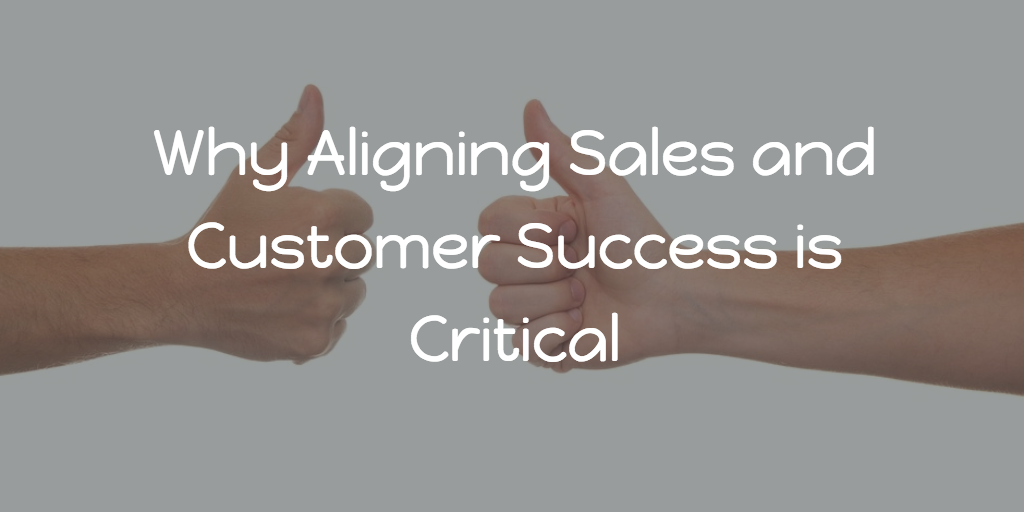 The goal of Customer Success for your company is to get customers to stay longer, buy more, and advocate for you.
The goal of Customer Success for your company is to get customers to stay longer, buy more, and advocate for you.
So it’s critical to remember that Customer Success begins at the first interaction with prospects by your sales team, continues across their entire lifecycle, and is required for scalable, repeatable Account Expansion.
Which means it’s absolutely critical for Sales and Customer Success Management to be aligned.
Let’s dig into this…
For context, on Friday, May 5, 2017, I did a Customer Success Ask Me Anything (AMA) on Facebook live. It was awesome. The video (audio only… sorry) is embedded below and below that is the transcript (edited for better readability) that answers the question.
Sales & Customer Success Alignment
The next question is from Bob, “I was curious about your thoughts on the alignment of our customer success and enterprise pre-sales teams. My question is if it makes sense to have CSM, CS architects and pre-sales all reporting under one leader. We sell a big ticket, 500k, ACV enterprise data management solution to large enterprises.”
I’ve covered Sales and Customer Success Alignment in some detail before, but let me approach it from a slightly different angle here.
The question is really about sales and customer success alignment. Whatever that needs to look like. Whatever that looks like in your situation … Bob has a specific situation, but we all have sales and we all have customer success hopefully. We all have those things and we want to make sure that they are aligned.
Alignment from a strategic standpoint, alignment from understanding what the Desired Outcome is for the customer or making sure that sales is not selling something that we can’t deliver, that sales knows what a bad fit customer is and doesn’t acquire them, that sales is handing off to customer success.
I don’t really like the term handoff, but it’s so ingrained I can’t even get away from it. We want to make sure that our customers … Whatever we get during the sales process, whatever we discover is really passed to whoever is going to take over once they become a customer so that we’re not having to ask them the same questions over and over. All of that is table stakes. We have to have that.
What that ends up actually looking like is going to be very unique from company to company and probably even across your different customer segments. That’s really important to think about. In terms of a specific situation like we have a high contract value product. Maybe it’s more of a complex sale.
We have more people involved on both sides, on the customer’s side as well as ours. How do we ensure that there’s that alignment? The main thing is we need to understand … Again, going back to appropriate experience, understanding that the appropriate experience for the customers, the way they buy … The way they buy is part of their Appropriate Experience. Appropriate Experience is something that goes across the entire customer lifecycle, goes across all of the different interactions.
It may be completely appropriate for a sales person to involve a customer success manager, a customer success architect, whatever customer service practitioner you want to … However you want to refer to them or whoever it is.
It may make total sense to include them in the sale process when a prospect is 50% of the way towards closing. On the other hand, it may make no sense. That would be completely unprecedented and it would completely inappropriate.
In that case, you may want to have your customer success practitioners vet the pipeline, look at the customers behind the scenes, make sure that they fit our success criteria, make sure that they’re a good fit in other ways, make sure that we know everything that needs to happen, make sure we understand what’s going on with the customer.
Where we don’t know if the customer is going to be able to be successful, we can give the sales person the right questions to ask the prospect in there.
Whether or not the customer service manager or customer success architect or whoever is actually involved with the customer in the pre-sales, again that depends on the appropriate experience for the customer.
Note that I didn’t say that it necessarily has anything to do with … Although we’re talking about Bob’s example of the high ticket item, actually it doesn’t have anything to do with how much a customer is going to pay us. It has everything to do with how much a customer needs those people to be involved in the pre-sales process.
That’s the main thing. You have to look at your situation, look at the customer, figure out whether or not we should actually involve a person with the customer, whether the CSP, the customer success practitioner, should be just behind the scenes.
I can’t give you a definitive answer, but hopefully that gets you thinking about this the right way. That alignment has to be there between sales and customer success. It’s really the triangle of customer success, marketing and sales. We should all be aligned. Way too often, we’re not, and I just don’t understand that.
There’s no reason for that. If we’re here to make our customer successful and we’re all working for the same company, we all have the same goals, we should all be aligned. That alignment should be there. Tactically how you make that happen is going to very much depend upon your situation and certainly depend upon your customers. I hope that helps a little bit.



